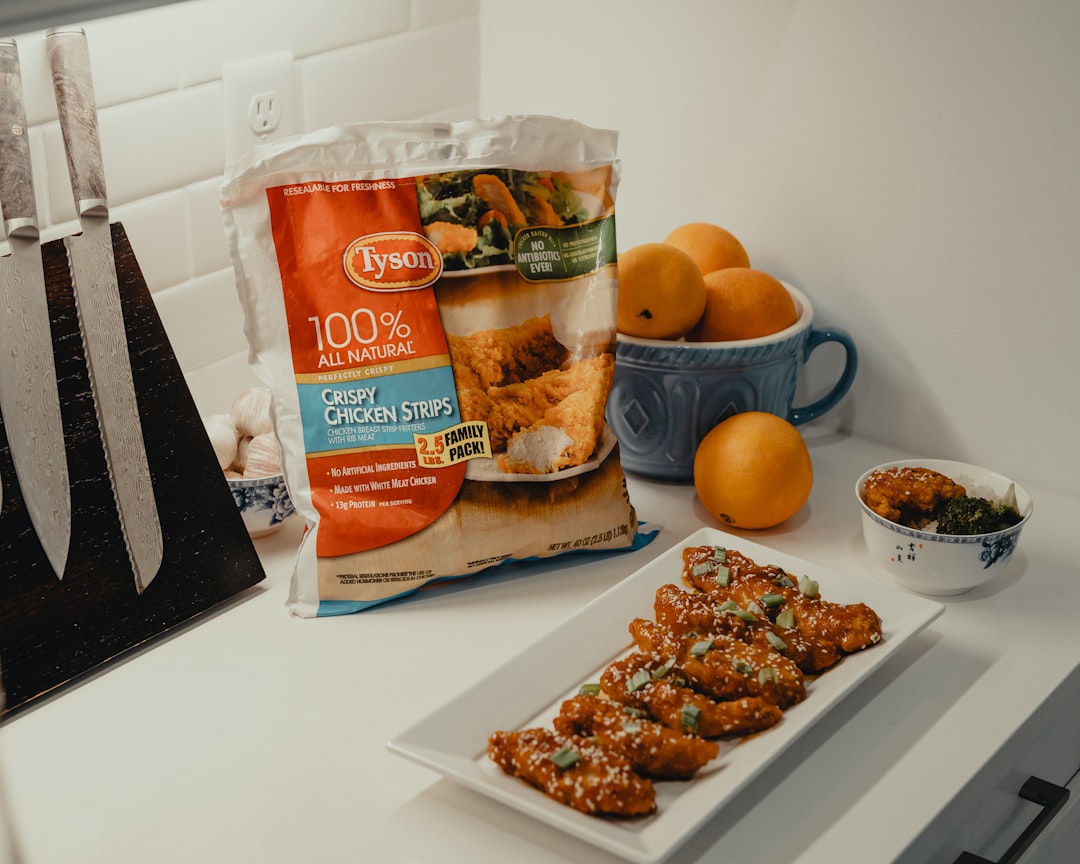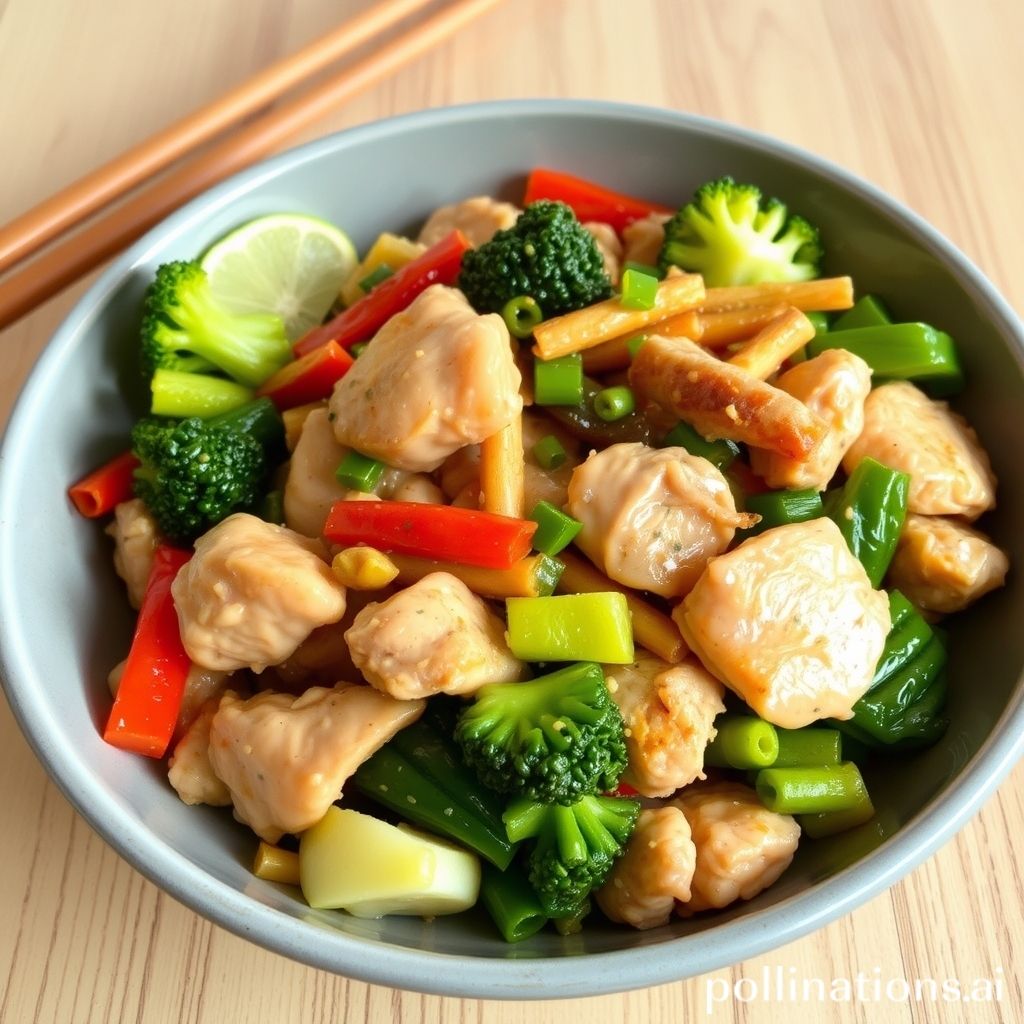Table of Contents
- Introduction
- Essential Ingredients for Chicken and Vegetable Stir-Fry
- Step-by-Step Cooking Instructions
- Tips for Choosing Fresh Vegetables
- Health Benefits of Chicken and Vegetable Stir-Fry
- Customizing Stir-Fry with Different Sauces
- Serving Suggestions and Pairings
- Storing and Reheating Leftovers
- Common Mistakes to Avoid
- Conclusion
- Frequently Asked Questions
Introduction
Welcome to the ultimate guide to crafting a delightful Chicken and Vegetable Stir-Fry that will tantalize your taste buds. Imagine vibrant vegetables mingling with succulent chicken, all kissed by a savory sauce that brings it all together in perfect harmony. Whether you’re a kitchen novice or a seasoned chef, this guide promises to elevate your stir-fry game to new heights.
Here’s what you will need:
- 1 lb of chicken breast, thinly sliced
- 2 cups of broccoli florets
- 1 red bell pepper, julienned
- 1 carrot, thinly sliced
- 1 cup of snap peas
- 2 cloves of garlic, minced
- 1 tablespoon of ginger, grated
- 3 tablespoons of soy sauce
- 2 tablespoons of oyster sauce
- 1 tablespoon of cornstarch
- 1/2 cup of chicken broth
- 2 tablespoons of vegetable oil
- 1 teaspoon of sesame oil
- Cooked rice, for serving
Intrigued? There’s much more to discover! We’ll delve into preparation techniques, stir-frying tips, and expert advice to ensure every bite is bursting with flavor and texture.
With our comprehensive guide, you’ll be well on your way to mastering this crowd-pleaser, perfect for busy weeknights or impressive weekend dinners. Let’s get cooking!
Essential Ingredients for Chicken and Vegetable Stir-Fry
To prepare a delicious chicken and vegetable stir-fry, it’s crucial to have the right ingredients on hand. The star of the dish is the chicken, typically boneless, skinless chicken breasts or thighs sliced thinly for quick cooking. Fresh vegetables are equally important; popular choices include bell peppers, broccoli, snap peas, carrots, and mushrooms. These ingredients add color, texture, and nutritional value to the dish.
The sauce is another key component. A basic stir-fry sauce often consists of soy sauce, oyster sauce, sesame oil, and a bit of cornstarch to thicken it. For an extra kick, you can add minced garlic, ginger, and red pepper flakes. Ensure you have some cooking oil with a high smoke point, such as canola or peanut oil, to achieve the high heat needed for stir-frying.
Don’t forget to have some rice or noodles on hand to serve as the base for your stir-fry. Optional garnishes such as sesame seeds and chopped green onions can add the finishing touch. With these essential ingredients, you can create a flavorful, balanced meal that is both satisfying and easy to prepare.
Step-by-Step Cooking Instructions
To prepare a delicious Chicken and Vegetable Stir-Fry, follow these simple steps. First, gather all your ingredients: chicken breast, a variety of fresh vegetables like bell peppers, broccoli, and carrots, soy sauce, garlic, ginger, and oil for frying.
Start by cutting the chicken breast into thin strips and seasoning them with a bit of salt and pepper. In a large skillet or wok, heat a tablespoon of oil over medium-high heat. Add the chicken strips and cook until they are no longer pink, usually about 5-7 minutes. Remove the chicken from the skillet and set it aside.
In the same skillet, add another tablespoon of oil and toss in minced garlic and grated ginger. Stir-fry for a minute until fragrant. Then, add your chopped vegetables to the skillet. Cook them for about 4-5 minutes, stirring frequently, until they are tender but still crisp.
Next, return the cooked chicken to the skillet with the vegetables. Pour in soy sauce and toss everything together to ensure the chicken and vegetables are well-coated. Stir-fry for another 2-3 minutes to combine the flavors. Your Chicken and Vegetable Stir-Fry is now ready to serve hot over steamed rice or noodles.
Tips for Choosing Fresh Vegetables
When it comes to making a delicious chicken and vegetable stir-fry, choosing fresh vegetables is crucial. Here are some tips to help you select the best produce for your dish. First, always check for firmness. Vegetables like bell peppers, carrots, and broccoli should feel firm and crisp. Soft spots might indicate that they are past their prime. Additionally, the color of the vegetables is a good indicator of freshness. Vibrant greens, reds, and yellows often mean that the veggies are packed with nutrients and flavor. Avoid any produce that appears dull or shows signs of discoloration.
Next, give the vegetables a sniff. Fresh veggies usually have a clean, earthy smell. If you notice any off-putting odors, it’s best to leave those behind. Also, don’t forget to check the stems and leaves. For example, leafy greens like spinach and kale should have perky, unblemished leaves, and the stems should be moist but not slimy.
Lastly, buy seasonal and locally-grown vegetables whenever possible. These are typically fresher and more flavorful because they haven’t traveled long distances. Using fresh vegetables in your stir-fry will not only enhance the taste but also provide maximum nutritional benefits.
Health Benefits of Chicken and Vegetable Stir-Fry
Chicken and vegetable stir-fry is not only a delicious and quick meal but also boasts a variety of health benefits. One of its primary advantages is its high nutrient density. Chicken is a great source of lean protein, which is essential for muscle repair, immune function, and maintaining healthy skin. Vegetables bring a wealth of vitamins, minerals, and antioxidants to the dish, including vitamin C, vitamin A, and potassium.
Another benefit is the low fat content, especially if you use skinless chicken breast and minimal oil. The presence of fiber from vegetables like broccoli, bell peppers, and snap peas aids in digestion and helps maintain a healthy gut. Additionally, the antioxidants in vegetables combat free radicals in the body, reducing the risk of chronic diseases such as heart disease and cancer.
Moreover, stir-frying is a cooking method that retains most of the nutrients in the ingredients due to its quick cooking time. It also allows for the use of various spices and herbs, further enriching the dish with additional health-promoting properties. Overall, chicken and vegetable stir-fry is a wholesome, balanced, and nutritious option for any meal.
Customizing Stir-Fry with Different Sauces
Customizing your chicken and vegetable stir-fry with different sauces can elevate the dish and offer a variety of flavor profiles to suit any palate. A classic option is soy sauce, which provides a savory umami taste that pairs well with just about any combination of vegetables and chicken. For those who enjoy a bit of heat, adding some chili sauce or sriracha can bring a spicy kick to the dish.
If you’re seeking a hint of sweetness, consider incorporating teriyaki sauce. This sauce blends soy sauce with sugar, mirin, and ginger for a rich and slightly sweet flavor. Another great option is hoisin sauce, which offers a thicker, sweeter profile often used in Chinese cuisine. It’s perfect for adding depth and complexity to your stir-fry.
For a tangy, citrusy note, try using a mix of lime juice and fish sauce. This combination is commonly found in Thai cuisine and provides a refreshing zest to your stir-fry. Oyster sauce is another versatile option, giving a slightly sweet and savory flavor that complements both chicken and a range of vegetables.
Experimenting with these different sauces can turn a simple stir-fry into a diverse and exciting meal, ensuring that you never get bored with your culinary creations.
Serving Suggestions and Pairings
Chicken and Vegetable Stir-Fry is a versatile dish that can be enjoyed in numerous ways. One popular serving suggestion is to pair it with steamed white or brown rice, offering a neutral base that absorbs the flavorful sauce. For a healthier alternative, consider serving the stir-fry over quinoa or cauliflower rice. If you prefer noodles, lo mein or soba noodles make excellent options that complement the textures and flavors of the stir-fry.
To elevate the meal, you can serve the stir-fry with a side of pickled vegetables, such as kimchi or pickled radish, which adds a tangy contrast. Another delightful pairing is a fresh Asian-inspired salad featuring ingredients like cucumber, carrot, and mint, dressed with a light sesame or ginger dressing.
Beverage pairings also play a crucial role in enhancing the dining experience. Green tea, jasmine tea, or a light beer like a pilsner can be refreshing choices that cleanse the palate. Alternatively, for those who enjoy wine, a crisp, unoaked Chardonnay or a Pinot Grigio would complement the flavors without overpowering them.
These serving suggestions and pairings can help you create a balanced meal that is both delicious and satisfying.
Storing and Reheating Leftovers
Storing and reheating leftovers from your Chicken and Vegetable Stir-Fry is simple and helps reduce waste. Start by allowing the stir-fry to cool to room temperature before storing it. Place the leftovers in an airtight container, ensuring it is sealed properly to maintain freshness. Store the container in the refrigerator where it can stay good for up to 3-4 days. For longer storage, consider freezing the stir-fry, which can extend its shelf life to about 2-3 months.
When reheating, evenly warm the leftovers to ensure they are safe to eat. For stove reheating, use a non-stick pan over medium heat, stirring occasionally until the dish is heated through. Adding a tablespoon of water or broth can help restore some moisture. If using a microwave, place the stir-fry in a microwave-safe dish, cover it with a microwave-safe lid or plastic wrap with a small vent, and heat on high for about 2-3 minutes, stirring halfway through to promote even heating. Always check that the dish is hot all the way through before serving. Proper storage and reheating help maintain the flavor and nutrition of your delicious stir-fry meal.
Common Mistakes to Avoid
Cooking a delicious chicken and vegetable stir-fry might seem straightforward, but there are common mistakes that can impact the final dish. One major mistake is overcrowding the pan. When too many ingredients are added at once, they steam instead of stir-fry, leading to soggy vegetables and bland chicken. It’s essential to cook in batches if necessary to ensure everything gets a proper sear.
Another common error is not prepping ingredients beforehand. Stir-frying is a fast process, and having all your vegetables, proteins, and sauces ready to go ensures that nothing will overcook or burn while you frantically chop or measure.
Using the wrong oil can also ruin your dish. Avoid oils with low smoke points, like olive oil, and opt for high smoke point oils such as peanut or canola oil to prevent burning.
Finally, failing to marinate the chicken can result in a lack of flavor. Marinating not only adds depth to the chicken but also helps tenderize it, making for a more enjoyable dish.
Conclusion
In conclusion, mastering the art of Chicken and Vegetable Stir-Fry is a culinary skill that brings numerous benefits to your table. From selecting the freshest vegetables to choosing the right sauces and avoiding common mistakes, this guide has covered everything you need to create a delicious, healthy meal. Whether you’re a novice cook or an experienced chef, stir-frying offers a quick and versatile way to enjoy a wholesome dinner.
But why stop here? Elevate your cooking to the next level with The Chicken Bible: Say Goodbye to Boring Chicken with 500 Recipes for Easy Dinners, Braises, Wings, Stir-Fries, and So Much More. This comprehensive guide offers an array of creative and mouth-watering chicken recipes that will transform your meals. Don’t miss out on this opportunity to expand your culinary horizons and impress your loved ones with new, exciting dishes. Purchase your copy today and let your kitchen adventures begin!

